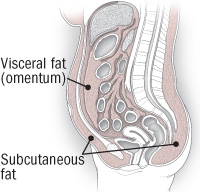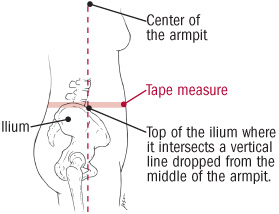Taking aim at belly fat
Unlike fat parked on the hips and thighs, fat around the middle produces substances that can create serious health risks.
No matter what your body shape, excess fat isn't good for your health. But saddlebags and ballooning bellies are not equivalent. When it comes to body fat, location counts, and each year brings new evidence that the fat lying deep within the abdomen is more perilous than the fat you can pinch with your fingers.
In most people, about 90% of body fat is subcutaneous, the kind that lies in a layer just beneath the skin. If you poke your belly, the fat that feels soft is subcutaneous fat. The remaining 10% — called visceral or intra-abdominal fat — lies out of reach, beneath the firm abdominal wall. It's found in the spaces surrounding the liver, intestines, and other organs. It's also stored in the omentum, an apron-like flap of tissue that lies under the belly muscles and blankets the intestines. The omentum gets harder and thicker as it fills with fat.
Although visceral fat makes up only a small proportion of body fat, it's a key player in a variety of health problems.
As women go through their middle years, their proportion of fat to body weight tends to increase — more than it does in men — and fat storage begins favoring the upper body over the hips and thighs. Even if you don't actually gain weight, your waistline can grow by inches as visceral fat pushes out against the abdominal wall.
Where's the fat?

Visceral fat lies in the spaces between the abdominal organs and in an apron of tissue called the omentum. Subcutaneous fat is located between the skin and the outer abdominal wall.
The trouble with visceral fat
Body fat, or adipose tissue, was once regarded as little more than a storage depot for fat blobs waiting passively to be used for energy. But research has shown that fat cells — particularly visceral fat cells — are biologically active. "One of the most important developments [since the mid-1990s] is the realization that the fat cell is an endocrine organ, secreting hormones and other molecules that have far-reaching effects on other tissues," says Dr. Barbara B. Kahn, chief of the division of endocrinology, diabetes, and metabolism at the Beth Israel Deaconess Medical Center in Boston.
Before researchers recognized that fat acts as an endocrine gland, they thought that the main risk of visceral fat was influencing the production of cholesterol by releasing free fatty acids into the bloodstream and liver. We now know that there's far more to the story. Researchers have identified a host of chemicals that link visceral fat to a surprisingly wide variety of diseases.
Subcutaneous fat produces a higher proportion of beneficial molecules, and visceral fat a higher proportion of molecules with potentially deleterious health effects. Visceral fat makes more of the proteins called cytokines, which can trigger low-level inflammation, a risk factor for heart disease and other chronic conditions. It also produces a precursor to angiotensin, a protein that causes blood vessels to constrict and blood pressure to rise.
Researchers at Harvard have discovered that, compared with subcutaneous fat, visceral fat secretes more of retinol-binding protein 4 (RBP4), a molecule that increases insulin resistance. As the volume of visceral fat increases, so do levels of RBP4. The connection is so strong that researchers are developing a blood test for RBP4 as a way for physicians to measure an individual's store of visceral fat.
Subcutaneous fat produces more of certain beneficial molecules, including the hormone leptin, which acts on the brain to suppress appetite and burn stored fat. Adiponectin, another hormone produced mainly by subcutaneous fat, helps protect against diabetes by regulating the processing of fats and sugars; it also has an anti-inflammatory effect on the linings of blood vessels. (Adiponectin is made by visceral fat, too, but production falls as fat volume increases.)
Gut check
A tape measure is your best home option for keeping tabs on visceral fat. Measure your waistline at the level of the navel — not at the narrowest part of the torso — and always measure in the same place. (According to official guidelines, the bottom of the tape measure should be level with the top of the right hip bone, or ilium — see the illustration — at the point where the ilium intersects a line dropped vertically from the center of the armpit.) Don't suck in your gut or pull the tape tight enough to compress the area. In women, a waist circumference of 35 inches or larger is generally considered a sign of excess visceral fat, but that may not apply if your overall body size is large. Rather than focus on a single reading or absolute cut-off, keep an eye on whether your waist is growing (are your pants getting snug at the waist?). That should give you a good idea of whether you're gaining unhealthy visceral fat.

From fat to disease
Visceral fat can be measured in a variety of ways. CT scans and full-body MRIs are the most precise, but they are expensive and rarely available, so investigators often use estimates based on waist circumference or waist size in proportion to height (see "Gut check"). To ensure that they're not just measuring overall obesity, researchers also check whether a person's waist circumference is higher than average for her or his body mass index (BMI).
Visceral fat is implicated in a number of chronic conditions, including these:
Cardiovascular disease. Several studies have documented this effect. For example, a large study of European women ages 45 to 79 concluded that those with the biggest waists (and those with the largest waists in relation to their hip size) had more than double the risk of developing heart disease. The risk was still nearly double even after adjustment for several other risk factors, including blood pressure, cholesterol, smoking, and BMI. Even in healthy, nonsmoking women, every 2 inches of additional waist size raised the risk for cardiovascular disease by 10%.
Higher visceral-fat volume also has a deleterious impact on several other heart disease risk factors. It tends to increase blood pressure and blood sugar levels, raise triglyceride levels, and lower levels of HDL (good) cholesterol. Taken together, these changes, known as metabolic syndrome, create a serious risk for cardiovascular disease and type 2 diabetes. In 2009, a consensus group of medical professional organizations agreed that abdominal obesity should be recognized as a major feature of metabolic syndrome.
Dementia. Researchers at Kaiser Permanente found that people in their early 40s with the highest levels of abdominal fat, compared with those who had the least abdominal fat at that age, were nearly three times more likely to develop dementia (including Alzheimer's disease) by their mid-70s to early 80s. Dementia was not associated with increased thigh size.
Asthma. In a large study of California teachers, women with high levels of visceral fat (a waist circumference of more than 35 inches) were 37% more likely to develop asthma than women with smaller waists — even if their weight was normal. The risks were highest for women who were both large-waisted and overweight or obese. The investigators believe that belly fat raises the risk of asthma more than other poundage because it has inflammatory effects throughout the body, including in the airways.
Breast cancer. A combined analysis of several studies found that premenopausal women with abdominal obesity (the largest waist size in proportion to their height) were at greater risk for breast cancer. Large waists were also linked to breast cancer risk among postmenopausal women, but that effect was not significant once BMI was taken into account.
Colorectal cancer. People with the most visceral fat have three times the risk of developing colorectal adenomas (precancerous polyps) than those with the least visceral fat, according to a Korean study in the American Journal of Gastroenterology (January 2010). The relationship was found after many other risks were accounted for. The researchers also confirmed that adenomatous polyps in the colon are associated with insulin resistance, which may be the mechanism that increases the cancer risk.
Keeping visceral fat at bay
Where you tend to gain fat depends on your genes, your hormones, your age, your birth weight (smaller babies more readily add belly fat later in life), and whether you've had children (women who have given birth tend to develop more visceral fat than women who haven't).
As young adults, women on average have less visceral fat than men, but that changes with menopause. In a four-year study at Louisiana State University tracking healthy middle-aged women, every one of them put on some subcutaneous belly fat, but only those who entered menopause added significant amounts of visceral fat. Lowered estrogen levels (which increase the proportional influence of testosterone) contribute to the shift toward a male pattern.
You can't change your birth weight or your genes, and you can't hold off menopause. (Studies are mixed about whether hormone replacement therapy influences visceral fat gain.) But there are several ways you can minimize the accumulation of visceral fat. The good news is that because it's more readily metabolized into fatty acids, it responds more efficiently to diet and exercise than fat on the hips and thighs. Here are some approaches that may help:
Keep moving. Exercise can help reduce your waist circumference. Even if you don't lose weight, you lose visceral fat and gain muscle mass. In the Louisiana study, the women going through menopause (those who gained visceral fat) also became less physically active.
Engage in at least 30 minutes of moderate-intensity activity most days, such as brisk walking or bicycling at a casual pace. Also, Kahn suggests, create opportunities to add motion to routine tasks. For example, park farther from your destination and walk the rest of the way, take the stairs instead of the elevator, and stand while you talk on the phone.
Studies have shown that you can help trim visceral fat or prevent its growth with both aerobic activity (such as brisk walking) and strength training (exercising with weights). Spot exercises, such as sit-ups, can tighten abdominal muscles but won't get at visceral fat.
Exercise can also help keep fat from coming back. In a study at the University of Alabama, Birmingham, dieting women lost an average of 24 pounds and reduced both visceral and subcutaneous fat, with or without aerobic or strength-training exercise. In the following year, those who maintained their exercise programs — a modest 40 minutes twice a week — maintained their visceral fat loss, while those who didn't exercise or abandoned their programs showed a 33% average increase in visceral fat.
Eat right. Choose a balanced diet that helps you achieve and maintain a healthy weight. Include plenty of calcium: according to another study from the University of Alabama, Birmingham, the more calcium a woman consumes, the less visceral fat she gains. Avoid products that seem to encourage belly fat deposition, including trans fats (hydrogenated vegetable oils) and fructose-sweetened foods and beverages.
Don't smoke. The more you smoke, the more likely you are to store fat in your abdomen rather than on your hips and thighs.
Get your sleep. Too little is bad. A five-year study found that adults under age 40 who slept five hours or less a night accumulated significantly more visceral fat. But too much isn't good, either — young adults who slept more than eight hours also added visceral fat. (This relationship wasn't found in people over age 40.)
Mind your mood. In the Study of Women's Health Across the Nation, middle-aged women who showed more hostility and had more depressive symptoms also had more visceral fat — but not more subcutaneous fat. In other studies, higher levels of the stress hormone cortisol were associated with a buildup of visceral fat even in lean women.
Forget the quick fix. Liposuction for cosmetic fat removal doesn't reach inside the abdominal wall.
-
Weight Loss Tweaking Your Lifestyle
Despite our national propensity to overeat, under-exercise, and grow s
-
Fad Diets: Why Are They Unhealthy?
Fad Diets: Why Are They Dangerous? It i
-
What To Do Every Hour To Lose Weight All Day
You can’t lose wei
-
Lose Weight Fast With Three Free Weight-Loss Remedies: Water, Air, And Prayer
The three most effective weight-loss remedies just happen to be fre
-
Drinks that help Burn Fat during Exercise
Exercise increases thermogenesis .i.e. the production of heat in the
-
A Guide to Female Hair Loss
Hair loss usually occurs because of hormonal factors. As a consequ
- DON'T MISS
- Weight Loss From Eating Fat Burning Foods
- Weight Loss Tips Three Key Areas That Benefit From Healthy Weight Loss
- Top Weight Loss Tricks - How You Can Get Rid Of Belly Fat
- The Quinoa Super Diet - Acai So 2008
- How To Make Stress Go Away Before It Really Shows Up
- Missy Elliott ‘Works It’ For H&M 70 Pounds Lighter
- 9 Hot Tips For Summer Weight Loss
- Weight Loss Foods That Actually Work Fast – Found!
- Facts You Should Know About How To Grow Taller
- How to Lose Weight at Home




